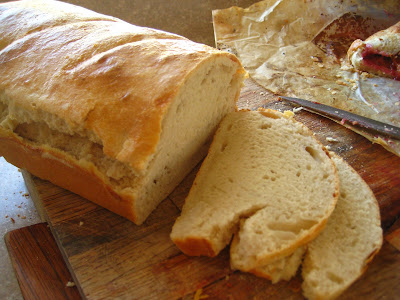

These pictures aren't so great because it was dark, and the more beautiful pizzas got eaten in less than one minute. Paul Clay thought that adding the green pepper would make it look more beautiful. hmm. The pizza was so so good, though. This one has goat cheese and prosciutto.
I decided to try this out since I'd been making so much bread and the recipe for pizza crust is almost identical to white bread's.
It seems that people usually try making pizza before making bread, so their crust isn't so good, but since I've made so much bread, my pizza dough was great! It's all about letting it rest and developing the gluten by kneading (but don't knead too much). The flavor gets a lot better if you let it rest overnight because it gets more acidity through cool fermentation.
I used a tomato sauce (like pasta sauce) we made with tomatoes from our garden, Parmesan and Asiago cheese, and some toppings my friend Cooper got (green peppers and mushrooms, prosciutto, salami, onion slices, etc.)
_________________________
Makes 6 6-ounce pizza crusts
Ingredients
4 1/2 cups unbleached bread flour (if you use all-purpose flour, omit the olive oil)
1 3/4 tsp salt
1 tsp instant yeast
1/4 cup olive oil
1 3/4 cups water (ice cold)
Cornmeal for dusting
Directions
1. Whisk together the flour salt and instant yeast in a 4-quart bowl. With a large metal spoon, stir in the oil and the cold water until the flour is all absorbed. Stir until you get an even dough, repeatedly dipping your hands or the metal spoon in cold water. Reverse the circular motion a few times to develop the gluten further. The finished dough will be springy, elastic, and sticky, not just tacky, and be at about 50°F (10°C).
2. Sprinkle flour on the counter and transfer the dough to the counter. Using a metal dough scraper (or a sharp knife), cut the dough into 6 equal pieces. You can dip the scraper into the cold water between cuts to keep the dough from sticking to it. Sprinkle flour over the dough. Make sure your hands are dry and then flour them. Lift each piece and gently round it into a ball. If the dough sticks to your hands, dip your hands into the flour again. Transfer the dough balls onto a lightly-oiled pan. Mist the dough generously with spray oil and slip the pan into a large plastic bag. Alternatively, after oiling the balls, put each one in a separate plastic bag.
3. Put the bag into the refrigerator overnight to rest the dough, or keep for up to 3 days. If you want to save some of the dough for future baking, you can store the balls in individual bags in the freezer (these will last 3 months max.) Transfer them into the refrigerator the day before you plan to make pizza.
4. On the day you plan to make the pizza, remove the desired number of dough balls from the refrigerator 2 hours before making the pizza. Dust the counter with flour, and then mist the counter with spray oil. Place the dough balls on top of the floured counter and sprinkle them with flour; dust your hands with flour. Gently press the dough into flat disks about 1/2 inch (1 1/3 cm) thick and 5 inches (13 cm) in diameter. Sprinkle the dough with flour, mist it again with spray oil, and cover the dough loosely with plastic wrap. Let rest for 2 hours.
5. At least 45 minutes before baking the pizza, place a baking stone on a rack in the lower third of the oven. Preheat the oven as hot as possible, up to 800°F (430°C) (most home ovens will only go up to 500°F (230°C)). If you do not have a baking stone, you can use the back of a sheet pan, but don't preheat the pan.
6. Generously dust a pizza peel or the back of a sheet pan with cornmeal. Make the pizzas one at a time. Dip your hands, including the backs, in flour and pick up 1 piece of dough by getting under it with a pastry scraper. Reinhart recommends tossing the pizza like they do at restaurants, but I couldn't figure it out. I was nervous about ripping the dough, so I used a rolling pin. Start rolling it out with a lightly-floured rolling pin. Do a quarter turn after every roll to ensure radial symmetry. Also flip over once in a while, adding enough flour so that it doesn't stick. If the dough keeps springing back (mine did), let it rest for 5 to 20 minutes so the gluten can relax, and try again.
7. When the dough is stretched out to your satisfaction, lay it on the peel or pan, making sure there is enough cornflour underneath to allow it to slide. Lightly top it with sauce and then with your other toppings, remembering that the best pizzas are topped with a less-is-more philosophy. The American "kichen-sink" approach is counterproductive, as it makes the crust more difficult to bake. Usually 3 or 4 toppings are sufficient. Less is more!
8. Slide the topped pizza on to the stone (or bake directly on the sheet pan) and close the oven door. Wait 2 minutes, then take a peek. The pizza should take 5 to 8 minutes to bake. If the pizza baked faster on one side than another, or top than bottom, then rotate the pan or move the rack.
9. Remove the pizza from oven and transfer to a cutting board. Wait 3 to 5 minutes before slicing and serving to allow the cheese to set slightly.
A good choice for cheeses is: a fresh hard bread (ie. Romano, Asiago, Parmesan), a good "melter" (ie. Mozzarella, Cheddar, or Gruyere), and any favorite (ie. goat, blue cheese).
Recipe from Peter Reinhart's The Bread Baker's Apprentice, Mastering the Art of Extraordinary Bread




























